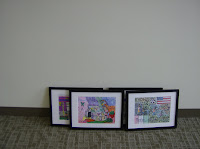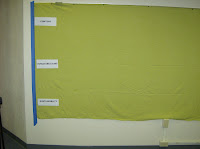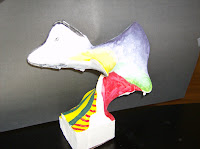
Personal Shrines and Altars: Visual Storytelling
We tell stories to reflect on our everyday experiences, the ordinary and the extraordinary. Some stories come from deep within, spoken from an inner voice, a kind of dialogue with the self. Shrines serve as a way of deep journaling using images and symbols rather than words. The dictionary defines a shrine as a receptacle for sacred relics and altar is defined as a raised structure, typically flat upon which sacred objects rest. Shrines and altars are about celebrating the story you’d like to share.
Story reveals themes, issues, and concerns of children, adolescents, and adults ….most of us collect and treasure souvenirs that are sacred to us. Sometimes people leave us, but they leave things behind. It is the small, inconsequential bric-a-brac that sometimes holds important memories.
The best reason of all to pursue this form of visual expression is that it brings forth an authentic voice. In telling a story, no matter how sad, tragic, funny, moving, remarkable, or ordinary, meaning is constructed visually.
Visual storytelling can come from within. But opportunities to work intuitively and reflectively allow the exploration of reactions and feelings, hopes and fears, connections and relationships, questions and concerns. This work can reflect an interplay between of the conscious and unconscious or the intellect with emotions.
Where I’m From Imagine yourself at a particular age, beginning at age 6, 7, 8, 9, or 10
1.I’m From… What would you see around your house during your childhood. List the items that characterize your environment.
2.I’m From… Step outside; describe what you see in your front yard, your sidewalk, the street, the neighborhood.
3.I’m From… Name relatives, particularly those that link you to your past.
4.I’m From… Sayings, expressions. What are some of the phrases you hear over and over again. Those that would distinguish your family from others.
5.I’m From… The names of foods and dishes that recall family gatherings, both daily meals and special treats.
6.I’m From… Name the place where your childhood memories are kept…whether realistically (photo albums, diaries, boxes) or metaphorically (the branches of a tree, the shadow of a particular porch).
Think about the beginning and ending of your poem…where you are from, who you are, and where you are going. Here's the poem I wrote for mysef:
Susan Megorden
WHERE I AM FROM
I am from shared space with my older sister, the lavender and white striped café curtains, twin beds with matching chenille bedspreads, hardwood floors that get buffed once a month with paste wax, no air-conditioning in 105 degree summer heat, and back porches that are screened in to keep the mosquitoes out.
I am from irrigation ditches that are dangerous to swim in, high diving boards at the BIG pool downtown, gooey asphalt on hot summer days, squishy apricots between your toes when the grass is too long, and roosters that like to swim in our wading pool.
I am from the house on Third Street with the palm trees all in a row, the home of Nana, Papoo, Mommy, Daddy, Jeff, Randi, Susan, Hank, Trina, and a never ending parade of cats.
I am from Darlin, Baby Blue Eyed Blonde, Spider, eat your vegetables!, there are children starving in China!, and Whose Fault Was This!
I am from liver and onions, Swiss steak, beef stroganoff, sucatash, lime cheese salad, stuffed celery, home-made olives, yellow cup-cakes without frosting, and pineapple upside down cake.
My roots are in the rich soil of the Sacramento Valley, my family cast a very broad shadow on this tiny place called Orland.
Ideas for Your Shrine
Honoring: Create a shrine for a part of yourself you wish to honor.
Remembering: Building a shrine can be a way to remember people who have influenced you greatly and who are no longer physically present in your life.
Healing: Making a shrine can be healing or simply a place of peace.
Attracting: Make a shrine that symbolizes something positive you would like to attract into your personal world.
Expressing: Shrines are the perfect medium for expressing thoughts, feelings, and experiences we normally keep hidden from the world. They provide us with the opportunity to express beauty and demonstrate our creativity.
Exploring: Creating a shrine can be an act of exploration…allow it to lead where it may.
Let your shrine be a work in progress; allow it to change as your understanding does. Remove and add images and objects. Rearrange them. Allow your shrine to grow and change as you do.
How to Create a Shrine
1.Choose a space.
2.Define the area...use a cloth, table, rock, etc. or decide on the form of your shrine
3.Be conscious of your intent
4.Gather and arrange objects that have meaning for you
5.Create additional objects for your shrine
We Create Shrines Everyday by Erika Ginnis
I believe we create shrines all the time, even if we are not conscious of it. Sometimes they are for things that we would not really choose to honor. That pile of bills we are ignoring in the corner looks like a shrine to a sense of lack.
I propose we become aware at some point of what the heck we are doing, so we can make choices about how we operate.
What kinds of altars do you see around you? Are there ones in your life you would change?









